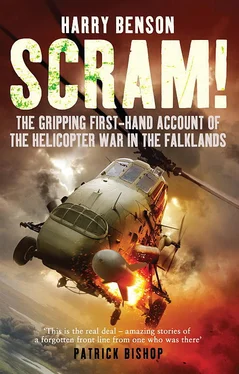Now that we could handle the basics, we moved on to Operational Flying Training where we learned to use the Wessex in its operating role. This involved winching, day and night load-lifting, troop-carrying, low-level flying, confined area landings, tactical formation, mountain flying (in Wales), search-and-rescue procedures, day and night deck-landings and 2-inch rocket firing.
Rocket firing at the range in Castlemartin, South Wales, was especially good fun. The seven students and two helicopter warfare instructors, Lieutenants Pete Manley and Paul Schwarz, took three aircraft away for a couple of days. Each of the Wessex was fitted with rocket pods. We could carry a maximum of twenty-eight rockets, seven in the top half and seven in the bottom half on each side. The firing range was an area of moorland and scrub leading to a cliff edge by the sea. Perched at the end was an old Second World War tank. The technique for firing was to approach the range at low level, about ninety degrees off target, pull up to about 1,000 feet and roll into a steep dive towards the target. The sighting system involved little more than lining up the cross hairs on a glass sight with a point on the windscreen behind it, marked with a chinagraph pen. It was hardly high-tech stuff and our accuracy reflected this. Although I did manage one hit out of the many rockets I fired, the proof of the pudding was that the tank was still there after years of Wessex firings and misses. Still, rockets might keep people’s heads down if ever used in anger.
Castlemartin was also fun for the evening entertainment. Those of us who hit the tank more by luck than judgment were required to buy champagne for the boys from the officers’ mess bar. Any excuse will do. But junglies are also known for their high jinks. Being a firing range, there was a plentiful supply of thunderflashes, very loud bangers that are used to simulate explosions or mortar fire. My very own personal introduction to the thunderflash came whilst minding my own business seated on the loo early in the evening. I heard the match strike. I saw the brown tube roll under the door. I saw the fizzing fuse. I leapt frantically out of the way into the corner of the cubicle and covered my head. Stupidly I failed to cover my ears. The rest of the evening in the bar passed with little need for conversation as I could hear nothing above the ringing in my ears.
The final training exercise, effectively completing my two and a half years of naval officer and pilot training, involved four days of military exercise (‘milex’) out on Dartmoor. We based four Wessex helicopters in the hills south of Okehampton. Aircrew and maintainers spent the next few days operating out in the field, working with a Royal Marine troop who alternated between the role of enemy troops attacking our base at 3 a.m. and friendly troops that we were tasked to support. It is extraordinarily demanding to fly a helicopter around Dartmoor at ninety knots at a height of fifty feet or less in loose tactical formation, whilst trying not to bump in to either the ground or the other aircraft, keep up with our fast-moving location on featureless terrain using a fifty thou’ ordnance survey map, and avoid wallpapering the cockpit with said map. As if this was not enough, our instructors added a few extra degrees of difficulty by occasionally switching off some valuable piece of avionics and telling us one of our radios or hydraulic systems or engines had failed. Or they would tell us to take over the lead and bring the formation into the planned drop zone. This meant actually knowing where we were rather than just following the leader and pretending. It meant thinking very quickly how best to approach the landing site and transmitting the new plan to the other aircraft. And it always meant taking in to account wind direction and tactical considerations. The expression ‘one-armed paper hanger’ was very familiar in junglie pilot circles.
Two friends on my course were chopped in the final weeks before going front line, one just before milex, one just after. The official explanation was that they weren’t good enough. Nevertheless both went on to become highly experienced commercial pilots. The unofficial explanation was defence cuts.
The remaining five of us completed our training and, on 1 March 1982, we joined 845 Naval Air Squadron as newly qualified Royal Navy pilots. More importantly, we had become junglies .
Friday 11 June 1982, Port San Carlos, Falkland Islands. Neil Cummins and I headed out across the muddy grass in the darkness. It was cold and windless. The first signs of dawn stretched across the horizon. A junior engineer followed just behind us to help with getting the Wessex started.
The huge green bird that was ours for the day sat with its rotor blades drooping heavily, restrained by red ‘tip socks’ that tied them to the fuselage like a bonnet. I could just make out the letters XL, X-Ray Lima, on the side. Between the three of us, we removed the tip socks and gathered together the other covers that protected the engine intake and exhausts from rain and water.
Remembering all of the vitally important checks around the aircraft ought to have been unnecessary as the maintainers had already thoroughly checked and serviced the aircraft earlier. But pilots are sticklers for procedure. I did a thorough walk around the helicopter as a final check. Human error is an easy way to kill yourself.
As I clambered over the aircraft, using brief flashes of my torch to check whether oil levels were sufficient and hatches were closed, I could see little flashes around me from the dozen other Wessex pilots getting ready for launch. I wondered what little idiosyncrasies I would find on this particular helicopter. I smiled as I opened the platform that allowed me to check the gearbox oil level. At least I knew there was some oil in this one.
A minute or so later I was putting on my helmet and Mae West lifejacket and climbing up into the cockpit. This aircraft had no heavy window armour, so I slid the door shut, adjusted the height of my seat, fiddled with the pedals, and strapped myself in. A hundred switches, knobs, levers and dials stared at me, challenging my next move. I flicked on the battery switch, plugged in my helmet lead, and adjusted my microphone. Neil Cummins was wearing his throat mike which, picking up vibrations in the vocal chords, gave a curiously metallic sound to his voice. I deciphered the inevitable ‘How do you read, boss?’ with practised ease.
‘Loud and clear.’
‘Loud and clear also.’
‘Ground power in please.’ He plugged the lead from the spare batteries into the side of the aircraft just below the exhaust pipe. It would give us an extra electrical boost when starting the first of our engines.
My hands and eyes ran quickly over the switches on the centre console between the pilots seats, switching some on, leaving others off, testing warning lights and generally preparing the electrics for start-up. I then raised my left hand to the radio panel in the roof and selected all the different frequencies I would require from my four radio sets, checking the numbers against what I had written on my knee pad during the pre-flight brief. Looking down onto the instrument panels I had a good look at every dial, running my eyes over them from left to right. Co-pilot’s dials, engine gauges, fuel flow meters, torque, and across to the pilot’s flight instruments in front of me that would tell me height, speed, rate of climb and aircraft attitude, amongst other things. With a full waggle of the two sticks, cyclic in my right and collective in my left, and a good kick on both pedals, I was ready to start in less than a minute.
‘Starting port,’ I said.
‘Roger,’ came the reply as I pressed the starter button down and held it. The engine beneath the co-pilot’s feet wound up slowly while it waited for ignition. The ignition unit crackers below me did their stuff. With a roar from the port exhaust outside the window to my left, the engine lit. I moved my hand to the fuel cut-off in case the temperature went too high. But after its speedy upward rise, the temperature needle dropped back as the increased airflow through the engine cooled things down. With a slight increase on the speed select lever or throttle, the generators came on line and I called for ground power to be unplugged. After checking that all the generator-powered electrics had also come on, I repeated the start procedure with the starboard engine. The engine roared into life with a loud blast outside below my window. I remembered to switch on the anti-icing system that prevents ice from building up in the intakes and damaging the engines.
Читать дальше












